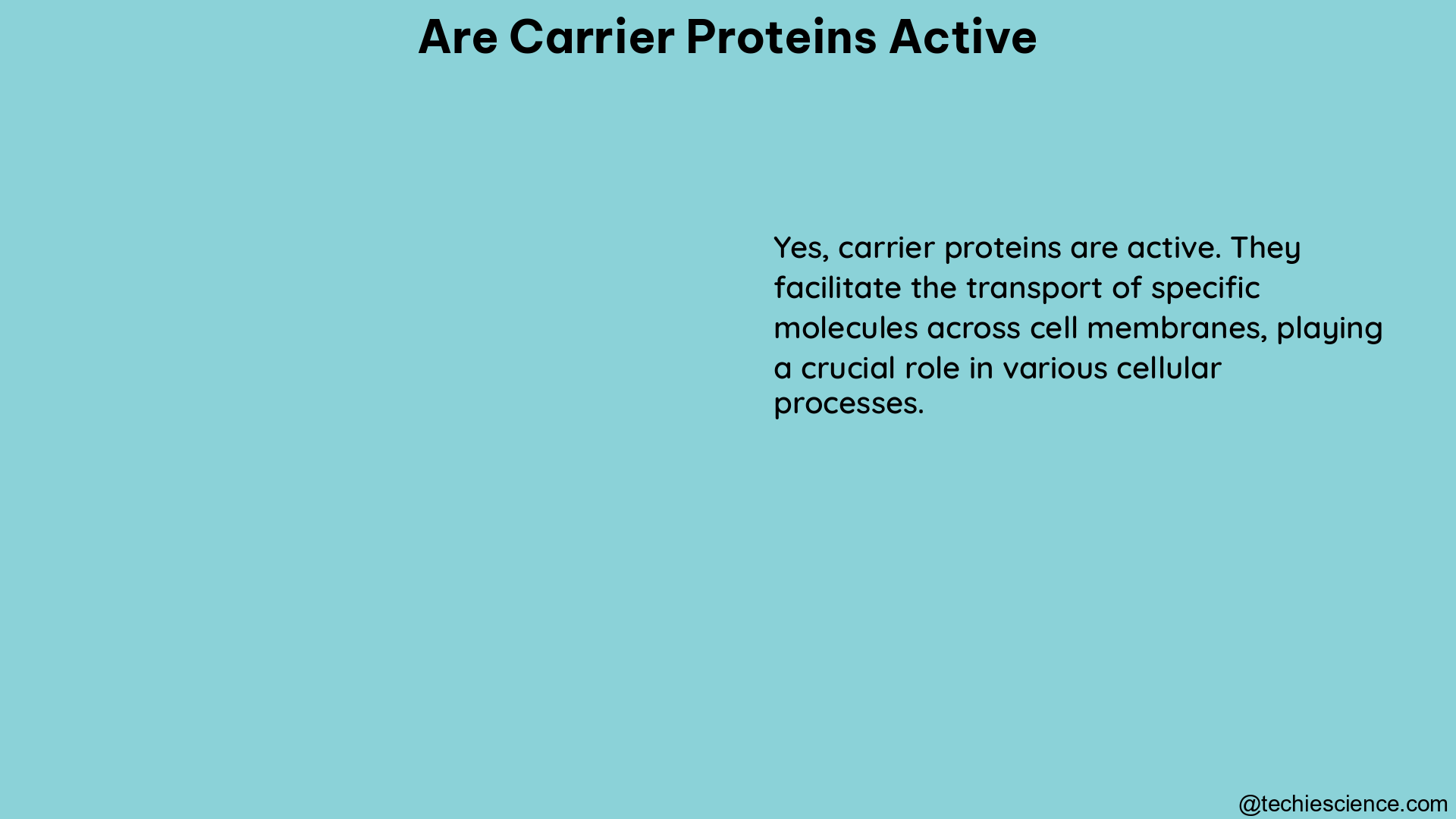Carrier proteins are essential components of cell membranes, responsible for the active transport of various substances across the lipid bilayer. These proteins play a crucial role in maintaining the delicate balance of ions, nutrients, and other molecules within the cell, ensuring optimal cellular function. In this comprehensive guide, we will delve into the intricacies of carrier proteins and explore the mechanisms that make them active participants in the transport process.
Understanding Carrier Proteins
Carrier proteins are a class of membrane-bound proteins that facilitate the movement of specific molecules or ions across the cell membrane. These proteins are designed to recognize and bind to their target substances, enabling their transport against the concentration gradient. This process, known as active transport, requires the input of energy, typically in the form of adenosine triphosphate (ATP) hydrolysis.
Structure and Binding Specificity
Carrier proteins possess a unique three-dimensional structure that allows them to selectively bind to their target substances. Each carrier protein has specific binding sites that are complementary to the shape and chemical properties of the molecules or ions they transport. This binding specificity ensures that the carrier protein can efficiently recognize and bind to its substrate, facilitating its movement across the membrane.
Conformational Changes
The active transport process mediated by carrier proteins involves a series of reversible conformational changes. When the carrier protein binds to its substrate on one side of the membrane, it undergoes a structural rearrangement that exposes the binding site on the opposite side of the membrane. This conformational change allows the substrate to be released on the other side of the membrane, completing the transport process.
Active Transport Mechanisms

The active transport of substances across the cell membrane using carrier proteins is a complex and energy-dependent process. Let’s explore the key mechanisms involved in this process:
ATP-Driven Active Transport
The primary energy source for active transport is the hydrolysis of ATP. The energy released from the breakdown of ATP is used to power the conformational changes in the carrier protein, enabling the transport of substances against their concentration gradient.
Sodium-Potassium Pump (Na+/K+ ATPase)
One of the most well-known examples of ATP-driven active transport is the sodium-potassium pump (Na+/K+ ATPase). This carrier protein is responsible for maintaining the electrochemical gradient across the cell membrane by actively transporting sodium ions (Na+) out of the cell and potassium ions (K+) into the cell. The energy required for this process is provided by the hydrolysis of ATP.
Calcium Pump (Ca2+ ATPase)
Another example of ATP-driven active transport is the calcium pump (Ca2+ ATPase), which is responsible for maintaining low intracellular calcium concentrations. This carrier protein actively transports calcium ions (Ca2+) out of the cell, using the energy released from ATP hydrolysis to power the conformational changes necessary for the transport process.
Proton-Gradient-Driven Active Transport
In some cases, the energy required for active transport is not directly derived from ATP hydrolysis, but rather from the proton gradient established across the cell membrane. This proton-gradient-driven active transport is commonly observed in mitochondria and chloroplasts, where the electrochemical gradient generated by the electron transport chain is used to power the transport of various substances.
Mitochondrial Carrier Proteins
Within the mitochondria, carrier proteins are responsible for the transport of metabolites, such as ADP, ATP, and various ions, across the inner mitochondrial membrane. These carrier proteins utilize the proton gradient established by the electron transport chain to drive the active transport of these essential molecules.
Chloroplast Carrier Proteins
In chloroplasts, carrier proteins are involved in the active transport of photosynthetic intermediates, such as triose phosphates and 3-phosphoglycerate, across the chloroplast envelope. The proton gradient generated by the light-dependent reactions of photosynthesis provides the energy required for this active transport process.
Factors Affecting Active Transport
The rate and efficiency of active transport mediated by carrier proteins are influenced by several factors:
-
Carrier Protein Concentration: The number of available carrier proteins in the cell membrane directly affects the rate of active transport. A higher concentration of carrier proteins can facilitate a greater number of transport events.
-
Substrate Concentration: The concentration of the transported substance on either side of the membrane can influence the rate of active transport. Higher substrate concentrations on the side of lower concentration can increase the driving force for transport.
-
ATP Availability: The availability of ATP, the primary energy source for active transport, is a crucial factor. Increased ATP levels can enhance the rate of active transport by providing more energy for the conformational changes in the carrier proteins.
-
Temperature: Temperature can affect the kinetics of the conformational changes in carrier proteins, as well as the overall rate of ATP hydrolysis. Optimal temperature conditions can maximize the efficiency of active transport.
-
Inhibitors: Certain substances, such as ouabain or vanadate, can act as inhibitors of specific carrier proteins, reducing or blocking their active transport capabilities.
Passive Transport and Carrier Proteins
While carrier proteins are primarily associated with active transport, they can also play a role in passive transport processes, such as facilitated diffusion. In these cases, the carrier proteins assist in the movement of substances down their concentration gradient, without the need for energy input.
Facilitated Diffusion
Facilitated diffusion involves the use of carrier proteins to transport substances across the cell membrane, down their concentration gradient. These carrier proteins provide a specific pathway for the movement of the transported substance, enhancing the rate of diffusion compared to simple diffusion through the lipid bilayer.
Comparison to Active Transport
The key difference between active transport and facilitated diffusion is the directionality of the transport process. Active transport moves substances against their concentration gradient, requiring the input of energy, while facilitated diffusion allows substances to move down their concentration gradient without the need for energy input.
Conclusion
Carrier proteins are indeed active participants in the transport of substances across cell membranes. Through their unique structural features and the energy-dependent conformational changes they undergo, carrier proteins play a crucial role in maintaining the delicate balance of ions, nutrients, and other molecules within the cell. Understanding the mechanisms and factors that influence the active transport mediated by carrier proteins is essential for a comprehensive understanding of cellular physiology and the maintenance of homeostasis.
References:
- Active Transport – Exchange and Transport Ep 4. ZHTutorials. https://zhtutorials.com/2020/12/12/active-transport/
- Carrier Proteins and Active Membrane Transport – NCBI. https://www.ncbi.nlm.nih.gov/books/NBK26896/
- Are carrier proteins active or passive? – BYJU’S. https://byjus.com/question-answer/are-carrier-proteins-active-or-passive/
- Membrane Transport Proteins – Boundless Biology. https://courses.lumenlearning.com/boundless-biology/chapter/membrane-transport-proteins/
- Active Transport – Molecular Biology of the Cell – NCBI Bookshelf. https://www.ncbi.nlm.nih.gov/books/NBK26871/
- Facilitated Diffusion – Molecular Biology of the Cell – NCBI Bookshelf. https://www.ncbi.nlm.nih.gov/books/NBK26878/

Hello, I am Piyali Das, pursuing my Post Graduation in Zoology from Calcutta University. I am very passionate on Academic Article writing. My aim is to explain complex things in simple way through my writings for the readers.